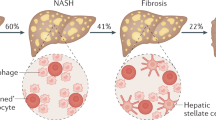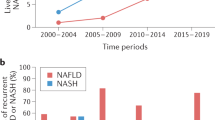Abstract
Nonalcoholic fatty liver disease (NAFLD) is an increasingly recognized health problem. Increased fat accumulation in the liver is observed in 20–30% of the population in the Western world, and in approximately 10% of this cohort it is associated with nonalcoholic steatohepatitis, which is characterized by inflammation and fibrosis. Disease presentation of NAFLD ranges from asymptomatic disease to cirrhosis with the complication of liver failure and hepatocellular carcinoma. NAFLD is suspected on the basis of various clinical aspects (an elevated alanine aminotransferase concentration, presence of obesity and diabetes) that alone are not sufficient to establish diagnosis or prognosis. The major diagnostic procedure is liver biopsy, which allows assessment of liver injury. In most cases, NAFLD is associated with insulin resistance, which is therefore the target of most current NAFLD treatment modalities. Various treatment strategies such as weight loss and/or exercise, thiazolidinediones, metformin, lipid-lowering agents and antioxidants have been studied. So far, no single intervention has convincingly improved liver histology. It is recommended that patients at high risk of developing advanced liver disease, and who are not part of controlled studies, should receive nutritional counseling and take physical exercise to achieve moderate weight loss and improve insulin sensitivity.
This is a preview of subscription content, access via your institution
Access options
Subscribe to this journal
Receive 12 print issues and online access
$209.00 per year
only $17.42 per issue
Buy this article
- Purchase on Springer Link
- Instant access to full article PDF
Prices may be subject to local taxes which are calculated during checkout
Similar content being viewed by others
References
Ludwig J et al. (1980) Nonalcoholic steatohepatitis: Mayo Clinic experiences with a hitherto unnamed disease. Mayo Clin Proc 55: 434–438
Angulo P (2002) Nonalcoholic fatty liver disease. N Engl J Med 346: 1221–1231
Marchesini G et al. (2001) Nonalcoholic fatty liver disease: a feature of the metabolic syndrome. Diabetes 50: 1844–1850
Sanyal AJ (2005) Mechanisms of disease: pathogenesis of nonalcoholic fatty liver disease. Nat Clin Pract Gastroenterol Hepatol 2: 46–53
Browning JD and Horton JD (2004) Molecular mediators of hepatic steatosis and liver injury. J Clin Invest 114: 147–152
Neuschwander-Tetri BA and Caldwell SH (2003) Nonalcoholic steatohepatitis: Summary of an AASLD single topic conference. Hepatology 37: 1202–1219
Tajiri K et al. (1997) Nonalcoholic steatohepatitis masquerading as autoimmune hepatitis. J Clin Gastroenterol 25: 538–540
Saadeh S et al. (2002) The utility of radiological imaging in nonalcoholic fatty liver disease. Gastroenterology 123: 745–750
Brunt EM et al. (1999) Nonalcoholic steatohepatitis: a proposal for grading and staging the histological lesions. Am J Gastroenterol 94: 2467–2474
Matteoni CA et al. (1999) Nonalcoholic fatty liver disease: a spectrum of clinical and pathological severity. Gastroenterology 116: 1413–1419
Dam-Larsen S et al. (2004) Long term prognosis of fatty liver: risk of chronic liver disease and death. Gut 53: 750–755
Jepsen P et al. (2003) Prognosis of patients with a diagnosis of fatty liver—a registry-based cohort study. Hepatogastroenterology 50: 2101–2104
Powell EE et al. (1990) The natural history of nonalcoholic steatohepatitis: a follow-up study of forty-two patients for up to 21 years. Hepatology 11: 74–80
Harrison SA et al. (2003) The natural history of nonalcoholic fatty liver disease: a clinical histopathological study. Am J Gastroenterol 98: 2042–2047
Fassio E et al. (2004) Natural history of nonalcoholic steatohepatitis: a longitudinal study of repeat liver biopsies. Hepatology 40: 820–826
Caldwell SH et al. (1999) Cryptogenic cirrhosis: clinical characterization and risk factors for underlying disease. Hepatology 29: 664–669
Angulo P et al. (1999) Independent predictors of liver fibrosis in patients with nonalcoholic steatohepatitis. Hepatology 30: 1356–1362
Gramlich T et al. (2004) Pathologic features associated with fibrosis in nonalcoholic fatty liver disease. Hum Pathol 35: 196–199
Younossi ZM et al. (2004) Nonalcoholic fatty liver disease in patients with type 2 diabetes. Clin Gastroenterol Hepatol 2: 262–265
Ratziu V et al. (2000) Liver fibrosis in overweight patients. Gastroenterology 118: 1117–1123
Dixon JB et al. (2001) Nonalcoholic fatty liver disease: predictors of nonalcoholic steatohepatitis and liver fibrosis in the severely obese. Gastroenterology 121: 91–100
Drenick EJ et al. (1970) Effect on hepatic morphology of treatment of obesity by fasting, reducing diets and small-bowel bypass. N Engl J Med 282: 829–834
Rozental P et al. (1967) Liver morphology and function tests in obesity and during total starvation. Am J Dig Dis 12: 198–208
Luyckx FH et al. (1998) Liver abnormalities in severely obese subjects: effect of drastic weight loss after gastroplasty. Int J Obes Relat Metab Disord 22: 222–226
Andersen T et al. (1991) Hepatic effects of dietary weight loss in morbidly obese subjects. J Hepatol 12: 224–229
Wang RT et al. (2003) Is weight reduction an effective therapy for nonalcoholic fatty liver? A systematic review. Am J Med 115: 554–559
Park HS et al. (1995) Effect of weight control on hepatic abnormalities in obese patients with fatty liver. J Korean Med Sci 10: 414–421
Ueno T et al. (1997) Therapeutic effects of restricted diet and exercise in obese patients with fatty liver. J Hepatol 27: 103–107
Ranlov I and Hardt F (1990) Regression of liver steatosis following gastroplasty or gastric bypass for morbid obesity. Digestion 47: 208–214
Dixon JB et al. (2004) Nonalcoholic fatty liver disease: Improvement in liver histological analysis with weight loss. Hepatology 39: 1647–1654
Harrison SA et al. (2003) Orlistat in the treatment of NASH: a case series. Am J Gastroenterol 98: 926–930
Harrison SA et al. (2004) A pilot study of orlistat treatment in obese, non-alcoholic steatohepatitis patients. Aliment Pharmacol Ther 20: 623–628
Kral JG et al. (2004) Effects of surgical treatment of the metabolic syndrome on liver fibrosis and cirrhosis. Surgery 135: 48–58
Baltasar A et al. (2004) Clinical hepatic impairment after the duodenal switch. Obes Surg 14: 77–83
Yki-Jarvinen H (2004) Thiazolidinediones. N Engl J Med 351: 1106–1118
Caldwell SH et al. (2001) A pilot study of a thiazolidinedione, troglitazone, in nonalcoholic steatohepatitis. Am J Gastroenterol 96: 519–525
Promrat K et al. (2004) A pilot study of pioglitazone treatment for nonalcoholic steatohepatitis. Hepatology 39: 188–196
Neuschwander-Tetri BA et al. (2003) Improved nonalcoholic steatohepatitis after 48 weeks of treatment with the PPAR-gamma ligand rosiglitazone. Hepatology 38: 1008–1017
Marchesini G et al. (2001) Metformin in non-alcoholic steatohepatitis. Lancet 358: 893–894
Uygun A et al. (2004) Metformin in the treatment of patients with non-alcoholic steatohepatitis. Aliment Pharmacol Ther 19: 537–544
Nair S et al. (2004) Metformin in the treatment of non-alcoholic steatohepatitis: a pilot open label trial. Aliment Pharmacol Ther 20: 23–28
Laurin J et al. (1996) Ursodeoxycholic acid or clofibrate in the treatment of non-alcohol-induced steatohepatitis: a pilot study. Hepatology 23: 1464–1467
Basaranoglu M et al. (1999) A controlled trial of gemfibrozil in the treatment of patients with nonalcoholic steatohepatitis. J Hepatol 31: 384
Rallidis LS et al. (2004) Pravastatin in patients with nonalcoholic steatohepatitis: results of a pilot study. Atherosclerosis 174: 193–196
Harrison SA et al. (2003) Vitamin E and vitamin C treatment improves fibrosis in patients with nonalcoholic steatohepatitis. Am J Gastroenterol 98: 2485–2490
Adams LA and Angulo P (2003) Vitamins E and C for the treatment of NASH: duplication of results but lack of demonstration of efficacy. Am J Gastroenterol 98: 2348–2350
Hasegawa T et al. (2001) Plasma transforming growth factor-beta1 level and efficacy of alpha-tocopherol in patients with non-alcoholic steatohepatitis: a pilot study. Aliment Pharmacol Ther 15: 1667–1672
Sanyal AJ et al. (2004) A pilot study of vitamin E versus vitamin E and pioglitazone for the treatment of nonalcoholic steatohepatitis. Clin Gastroenterol Hepatol 2: 1107–1115
Abdelmalek MF et al. (2001) Betaine, a promising new agent for patients with nonalcoholic steatohepatitis: results of a pilot study. Am J Gastroenterol 96: 2711–2717
Lindor KD et al. (2004) Ursodeoxycholic acid for treatment of nonalcoholic steatohepatitis: results of a randomized trial. Hepatology 39: 770–778
Yoshiji H et al. (2001) Angiotensin-II type 1 receptor interaction is a major regulator for liver fibrosis development in rats. Hepatology 34: 745–750
Yokohama S et al. (2004) Therapeutic efficacy of an angiotensin II receptor antagonist in patients with nonalcoholic steatohepatitis. Hepatology 40: 1222–1225
Tilg H and Diehl AM (2000) Cytokines in alcoholic and nonalcoholic steatohepatitis. N Engl J Med 343: 1467–1476
Satapathy SK et al. (2004) Beneficial effects of tumor necrosis factor-alpha inhibition by pentoxifylline on clinical, biochemical, and metabolic parameters of patients with nonalcoholic steatohepatitis. Am J Gastroenterol 99: 1946–1952
Colditz GA et al. (1995) Weight gain as a risk factor for clinical diabetes mellitus in women. Ann Intern Med 122: 481–486
Eriksson S et al. (1986) Nonalcoholic steatohepatitis in obesity: a reversible condition. Acta Med Scand 220: 83–88
Silverman EM et al. (1995) Regression of hepatic steatosis in morbidly obese persons after gastric bypass. Am J Clin Pathol 104: 23–3155
Acknowledgements
The authors' work is supported by the Austrian Science Fund.
Author information
Authors and Affiliations
Corresponding author
Ethics declarations
Competing interests
The authors declare no competing financial interests.
Rights and permissions
About this article
Cite this article
Tilg, H., Kaser, A. Treatment strategies in nonalcoholic fatty liver disease. Nat Rev Gastroenterol Hepatol 2, 148–155 (2005). https://doi.org/10.1038/ncpgasthep0116
Received:
Accepted:
Issue Date:
DOI: https://doi.org/10.1038/ncpgasthep0116
This article is cited by
-
Role of exercise in the mechanisms ameliorating hepatic steatosis in non-alcoholic fatty liver disease
Sport Sciences for Health (2018)
-
Effective kinetics of schisandrin B on serum/hepatic triglyceride and total cholesterol levels in mice with and without the influence of fenofibrate
Naunyn-Schmiedeberg's Archives of Pharmacology (2011)
-
Effect of High Fat Diet on the Volume of Liver and Quantitative Feature of Kupffer Cells in the Female Rat: A Stereological and Ultrastructural Study
Obesity Surgery (2007)
-
Alleviation of hepatic steatosis accompanied by modulation of plasma and liver TNF-α levels by Trigonella foenum graecum (fenugreek) seeds in Zucker obese (fa/fa) rats
International Journal of Obesity (2006)
-
Relationship of Metabolic Risk Factors and Development of Cardiovascular Disease and Diabetes
Obesity (2006)



